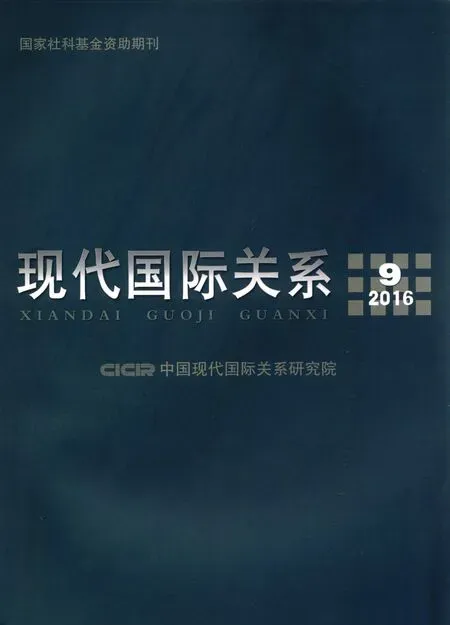Abstracts
2016-11-26TheDollarHegemonyandtheFutureofRMB
The Dollar Hegemony and the Future of RMB
Li Wei
A Comparative Study and Political Economic Analysis on the Economic Promises by the Presidential Candidates
Zhai Dongsheng & Zhao Yuxuan
An Analysis of Hillary Clinton’s Political Psychology and Her Policy Orientation toward China
Yin Jiwu
An Analysis of the “Make in India” Campaign and India’s Economic Prospects
Li Li
The Reform of the International Tax Regime and Its Future Development
Xu Feibiao & Chen Lu
s
The Dollar Hegemony and the Future of RMB
LiWei
Abstract: In the wake of the Eruption of American Financial Crisis of 2008, the start of RMB internationalization in 2009 and the spread of European Debt Crisis in 2010, the debate concerning about the new patterns of the international currency competition are unfolding in the circles of both academia and policy making. One school holds that the US dollar is on decline and the international monetary system is on the road to the multicurrency system. The other school argues that the hegemonic status of the US dollar has never been shaken and other currencies are still very hard to play the function of international currency in the world market due to their structural and technological weakness. The paper tries to make some responses to the above debate through the analysis of the data of 2007-2015. On the basis of this, this paper will further discuss the rise of RMB to a main international currency and its internal and external challenges.
the US dollar Hegemony, the Rise of RMB, Multicurrency System, Unipolar Currency System, International Currency Competition
A Comparative Study and Political Economic Analysis on the Economic Promises by the Presidential Candidates
ZhaiDongsheng&ZhaoYuxuan
Abstract: By systematically comparing the economic policy promises made by the two presidential candidates of the United States 2016 election, the paper aims illuminating the different impacts of the different campaign outcomes on the economic prospect of the U.S. as well as the world. The question of why the middle class failed in the past decades dominates the 2016 election, and the answers provided by the two candidates differ from each other, hence the solutions conflict with each other. Hillary Clinton relies not only on the redistribution of wealth to expand the aggregate demand, but also on long-term investment in innovation and infrastructure to improve the competitiveness of the U.S. economy. Donald Trump believes that dramatic tax cuts and trade protectionism will not only pull the U.S. out of the mud of disinflation and weak growth, but also bring benefit to his constituency, especially the white middle class.
Keyword: US presidential election, US economy, Sino-US relation
An Analysis of Hillary Clinton’s Political Psychology and Her Policy Orientation toward China
YinJiwu
Abstract: The personality and cognitive style of national leaders are highly influential variables to foreign policy decision-making and international relations. In terms of political personality and cognitive style, Hillary Clinton who is the Democratic Party’s candidate in 2016 US presidential election shows her tough and open-minded traits. More specifically, Hillary’s character is active-positive, power orientation, open-minded, rigid and cognitive flexible. Hillary’s historic memory toward China is biased and negative. Value-oriented diplomacy is the foundation of her political ideas. Nevertheless interest balance is also an important factor in her political considerations. The realistic reason why Hillary stresses a system of rules is to constrain China through shaping and strengthening the US-dominated system. Some other situational variables should also be included in analyzing what and how Hillary will influence China-US relations.
Key Words: US election, Hillary Clinton, Personality, Cognitive style, Policy Orientation toward China
An Analysis of the “Make in India” Campaign and India’s Economic Prospects
LiLi
Abstract: The “Make in India” campaign is an important economic strategy of the Modi government in India. It aims to transform India into a global manufacturing hub, maintain the momentum of rapid growth, and “make the 21st century India’s century”. Therefore, the Modi government has taken a series of measures as follows: improving ease of doing business, attracting foreign direct investment, and encouraging innovation and start-ups. However, the strategy has been implemented at a relatively slow pace due to poor infrastructure, unskilled labor force, inefficiency of India’s democracy and others. The “Make in India” campaign becomes an important indicator of the future trajectory of India’s economic growth.
Keywords: Make in India, India’s Economy
The Reform of the International Tax Regime and Its Future Development
XuFeibiao&ChenLu
Abstract: The International Tax Regime (ITR) is experiencing its first substantial transformation in almost a century, which will inevitably and deeply affect global investment and world economy. From the views of international political economy, the article first defines the concept of the ITR and combs its development history briefly, then concentrates on the critical analysis of the ongoing reform of ITR, and its future trend of development. The conclusion is that there are dramatic changes in the peripheries of the existing ITR, and it will continue to move towards a new regime of multilateralization and multipolarization.
Key Words: the International Tax Regime, Tax Reform, BEPS
(Edited by Zhao Jinfu)
